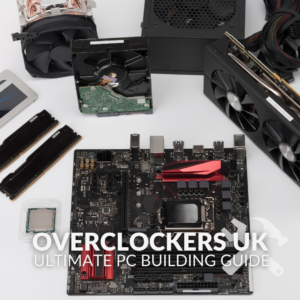ASUS BTF components are the future of gaming hardware, boasting support for the latest advancements in tech, outstanding aesthetics, and minimalistic designs.
With BTF hardware only just hitting the virtual shelves, we’ve compiled everything you need to know into one informative article. We’re showcasing what BTF components are, how they work, and all the hardware you need to create your very own BTF gaming PC.

What Are BTF Components?
BTF, Back To the Future or Back to Front, is the new line-up of hardware from ASUS, engineered to deliver a clean, seamless PC design by harnessing powerful hidden connectors on the underside of the motherboard.
ASUS BTF components are split into two categories – BTF and Advanced BTF.
BTF
A standard BTF motherboard features hidden connectors on the back. All your components plug into the front of the motherboard, and unwanted cables into the back. This facilitates easy cable management and a clean interior, allowing for near-zero clutter.
What’s more, a BTF motherboard streamlines the building process for both beginners and veterans alike, as you’ll only need to worry about battling cables on the back of the motherboard. This removes the hassle of trying to access all those hard-to-reach spots to plug things in or manage cables.

Advanced BTF
Advanced includes a BTF motherboard, graphics card, and PC case. This configuration allows you to harness the high-powered PCIe connector on the GPU and motherboard, capable of delivering up to 600W. What’s more, you can enjoy an uninterrupted view of the interior of your PC, with no unwanted cables disrupting your clean aesthetic.

Why You Want Hidden Connectors in Your Gaming PC
If you’re still on the fence about hidden connectors, we’ve rounded up all the pros and cons below.
Pros
- Minimal cable clutter.
- Clean and easy cable management.
- Delivers an uninterrupted view of your hardware.
- Better cooling. No need to worry about tangled wires affecting airflow.
- Improved aesthetics.
- Hidden connector hardware is available from a wide variety of manufacturers, including Project Stealth (Gigabyte) and Project Zero (MSI).
Cons
- Typically, more expensive than traditional layouts – Advanced BTF requires a motherboard, graphics card, and compatible PC case.
- Not cross-compatible with standard PC hardware or models from other manufacturers. E.g. BTF hardware will only work with BTF hardware, not with Project Zero.
Learn More About PC Building
Will You Be Upgrading to BTF?
Will you be upgrading to a BTF gaming PC? What are your thoughts on cableless gaming hardware? Let us know in the comments below.




Great idea on paper, but if the manufacturers continue to leverage their own standards, it’s not going to catch on. No one builds a PC purely with e.g. Asus, or Gigabyte components, you shop around and buy the ones that most fit your needs and budget. Similar to every other PC component design, the manufacturers need to work to common standards, or it just won’t be successful. Remember BluRay and HD-DVD?
This is how things always go. BluRay is just one example. VHS/BetaMax was another. One of these manufacturers will just have to prove why their proprietary solution is the best one, and eventually the others will fall in line. I don’t see a problem with allowing them to compete via traditional means to figure that out.